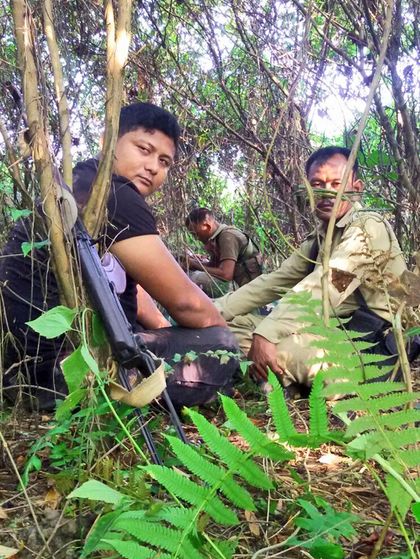It is hostile territory, made doubly dangerous by thick foliage, torrential rain and the presence of wild animals—rhinos, elephants and bears, apart from leeches of various sizes.
It is 3.30am on June 8, four days after militants attacked an Army convoy in Manipur, killing 18 personnel. Sanjyukta Parashor, 36, superintendent of police in Sonitpur in Assam, is leading a patrol in search of Bodo militants deep inside the reserve forest in the district. The scene of action is expected to be the Maldang area in the forest, 80km north of Tezpur, the district headquarters.
The contingent comprises about 50 commandos of the Assam Police and CoBRA (Commando Battalions for Resolute Action) of the Central Reserve Police Force. All of them are armed with AK-47 rifles, their footsteps cutting through foliage. Suddenly, a policeman leaps forward and reaches for Parashor's face. The SP remains calm as he pulls three tiny leeches from her face.
“When we are on an operation, this is very normal,” she tells me later. “Everyone just helps each other.” Then she moves on, slinging her AK-47 like a handbag.

We started off from Tezpur in cars, covering about 55km to reach the forest area. Then began the march deep into the forest. Parashor, a 2006 batch IPS officer, led from the front.
Since the area is unbearably humid, security forces usually carry out operations under cover of darkness: either late at night or before dawn. They still have to brave heavy rain and fast currents of shallow streams in the forest.
A CoBRA commando, who has been part of many such operations, describes the terrain: “We encounter elephants and other animals, particularly during our night operations. In such situations, we have no option but to either retreat or wait for animals to clear the way on their own.”
As the convoy progresses, bunches of leeches suddenly fall from trees. At another place, we have a river to cross. Parashor crosses it first and then signals the men with her hand. “Chhota kadam, chhota kadam,” she shouts. Short steps make it easier to cross the waters.
“It is all about individual ability to take the forces with you,” says Parashor. “So far, I have not found any difficulty in dealing with jawans and commanders of either the CRPF or the Assam Rifles. For the past six months, she says, “we have been able to crack down on militants by killing 11 of them and arresting 348 cadre and linkmen”. Last month, her team arrested four members of the militant National Democratic Front of Bodoland-Songbijit (NDFB-S). Coordinating the operations of different security forces has always been an issue in areas affected by insurgency. The situation in Sonitpur, however, is an exception. For the past 15 months, Parashor has been leading operations against Bodo militants here. She has gunned down 16 militants and arrested 64, besides recovering an impressive array of arms and ammunition from them. With her reputation as an “iron lady”, hers is the face that Bodo militants fear the most.
 Assam Police personnel resting in the forest during a search operation.
Assam Police personnel resting in the forest during a search operation.
In December 2014, insurgents killed 62 civilians in Sonitpur and Kokrajhar. “This was an act of desperation,” says Parashor. Ever since the massacre, security forces in Kokrajhar, Udalgiri, Baksa and Chirang have clamped down on militants in a coordinated manner.
The reserve forest has been a fertile ground for Bodo militants. With the state unable to set up infrastructure within the forest, villagers have encroached on the land. And the militants exploit the villagers.
Amid the heavy rain, the patrol stops at the home of an NDFB-S member who was arrested and granted bail some time ago. Parashor asks her troops to call him out of the house. His relatives, however, say he is not at home. After questioning the family, the patrol moves on.
The crackdowns in recent times have put militants on the backfoot. But security forces know that they have won only battles, and not the war. “We know they are here,” says a policeman who has been part of anti-militant operations for the past eight years. “We can’t let our guard down.”
Despite their best efforts, the forces find it difficult to gather information about the movement of militants. “They always get information about our movements from the local population by threatening them,” says a police officer. “If the element of surprise is not there, an operation [against militants] is bound to fail.”
Over the years, security personnel have picked up the militants' tricks of the trade and used them against the militants. “The tactics [we now use] were not part of our training. We have learnt them on the ground,” says an officer.
Can’t we use technology to track militants? Parashor offers a swift reply: “No matter what technology is used for tracking insurgents or criminals, you still have to go and catch them physically.”







